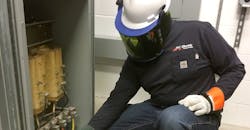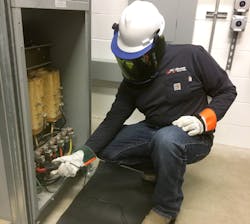Today, many companies need to renew their arc flash programs because their original studies were completed between 2010 and 2014 and are now facing or have passed the “five-year milestone.” NFPA 70E requires arc flash study data to be reviewed periodically, not to exceed five years. See NFPA 70E-2018, Sec. 130.5(H).
When many of these companies first paid for an arc flash study, they viewed it as a one-time project versus one of the important building blocks of an ongoing electrical safety program. A key question to ask now is, “Where was the vision to manage arc flash data as an ongoing requirement within the scope of the first project?” Unfortunately, some arc flash study providers are offering more of the same today — another one-time “labels-only project.”
For most “old arc flash studies,” the data collection process was a collection of a series of paper-based forms and drawings. The data was loaded into the engineering software that created the incident energy calculations, the labels were printed, sent off to the customer, and the project invoice followed. Given how the NFPA 70E standard has evolved, a “labels-only” project should no longer be acceptable.
Section 130.3 of the 2009 edition of NPFA 70E included a single reference to the text “condition of maintenance” as a requirement of the arc flash study. Today, the very mission statement of the standard (2018 edition, Sec. 90.2 Scope) includes a reference to “safety-related maintenance.” Additionally, Sec. 110.1(B) and Sec. 110.1(C), as well as other sections, address the concept that these data collection methods of the past are very much outdated. The whole of Chapter 2, “Safety Related Maintenance Requirements,” should also be part of your site’s overall electrical safety program.
When considering an arc flash analysis renewal project, the arc flash study should look to encompass the following:
- Recognize that arc flash labels are one of the building blocks of an electrical safety program, not just a project deliverable.
- The electrical safety program must describe the electrical equipment condition of the maintenance program even if the condition of maintenance tasking is done separately from the data collection requirements to develop the arc flash study.
- Consider that maintenance of the electrical system in terms of tests and inspections can be efficiently combined with the management of the arc flash study device profiles/data.
Additional factors to consider when managing your site’s arc flash program may include:
- The general requirements of NFPA 70B, Recommended Practice for Electrical Equipment Maintenance, suggest that electrical components receive some form of inspection, maintenance, and testing “within a period not to exceed three years.”
- How long should new and changed devices go without an arc flash label or one that is no longer accurate?
For most organizations, the EHS/safety resources are championing the requirements of arc flash labeling and employee training, while the maintenance/facility staff is responsible for reliability and maintenance. Those organizations with a strong grasp of the NFPA 70E standard have developed a collaborative effort to build out their electrical safety program and its many facets — both regulatory (labels) and functionally (condition of maintenance).
Fox is the owner of ASG Electric in Madison, Wis. He has held the NFPA Certified Electrical Safety Compliance Professional (CESCP) certification since 2014. He can be reached at [email protected].
About the Author
Chuck Fox, CESCP
Owner
Chuck Fox is the president and founder of PowerSafe Consulting. He’s been an NFPA Certified Electrical Safety Compliance Professional since 2014. He can be reached at [email protected].

